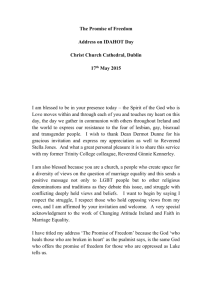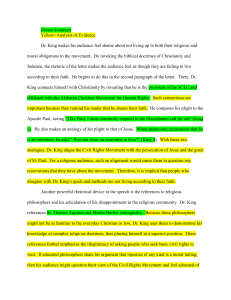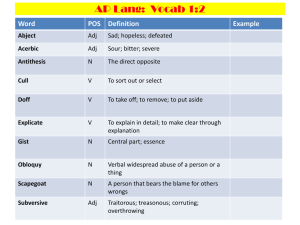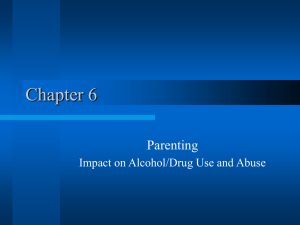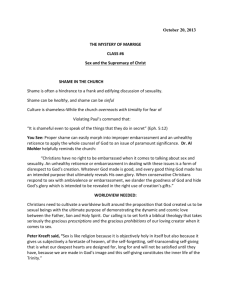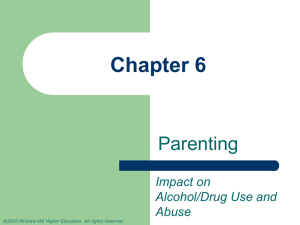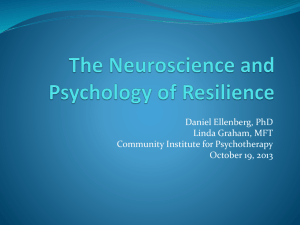97. Testing Elias`s "Invisible Shame" Thesis
advertisement
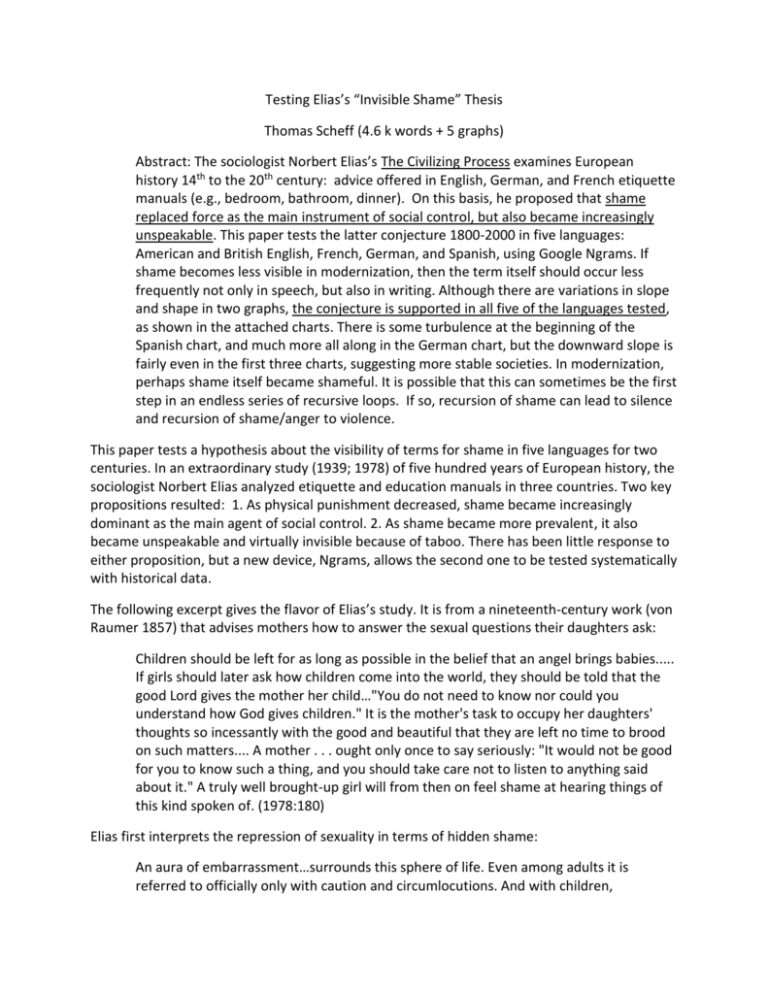
Testing Elias’s “Invisible Shame” Thesis Thomas Scheff (4.6 k words + 5 graphs) Abstract: The sociologist Norbert Elias’s The Civilizing Process examines European history 14th to the 20th century: advice offered in English, German, and French etiquette manuals (e.g., bedroom, bathroom, dinner). On this basis, he proposed that shame replaced force as the main instrument of social control, but also became increasingly unspeakable. This paper tests the latter conjecture 1800-2000 in five languages: American and British English, French, German, and Spanish, using Google Ngrams. If shame becomes less visible in modernization, then the term itself should occur less frequently not only in speech, but also in writing. Although there are variations in slope and shape in two graphs, the conjecture is supported in all five of the languages tested, as shown in the attached charts. There is some turbulence at the beginning of the Spanish chart, and much more all along in the German chart, but the downward slope is fairly even in the first three charts, suggesting more stable societies. In modernization, perhaps shame itself became shameful. It is possible that this can sometimes be the first step in an endless series of recursive loops. If so, recursion of shame can lead to silence and recursion of shame/anger to violence. This paper tests a hypothesis about the visibility of terms for shame in five languages for two centuries. In an extraordinary study (1939; 1978) of five hundred years of European history, the sociologist Norbert Elias analyzed etiquette and education manuals in three countries. Two key propositions resulted: 1. As physical punishment decreased, shame became increasingly dominant as the main agent of social control. 2. As shame became more prevalent, it also became unspeakable and virtually invisible because of taboo. There has been little response to either proposition, but a new device, Ngrams, allows the second one to be tested systematically with historical data. The following excerpt gives the flavor of Elias’s study. It is from a nineteenth-century work (von Raumer 1857) that advises mothers how to answer the sexual questions their daughters ask: Children should be left for as long as possible in the belief that an angel brings babies..... If girls should later ask how children come into the world, they should be told that the good Lord gives the mother her child…"You do not need to know nor could you understand how God gives children." It is the mother's task to occupy her daughters' thoughts so incessantly with the good and beautiful that they are left no time to brood on such matters.... A mother . . . ought only once to say seriously: "It would not be good for you to know such a thing, and you should take care not to listen to anything said about it." A truly well brought-up girl will from then on feel shame at hearing things of this kind spoken of. (1978:180) Elias first interprets the repression of sexuality in terms of hidden shame: An aura of embarrassment…surrounds this sphere of life. Even among adults it is referred to officially only with caution and circumlocutions. And with children, particularly girls, such things are, as far as possible, not referred to at all. Von Raumer gives no reason why one ought not to speak of it with children. He could have said it is desirable to preserve the spiritual purity of girls for as long as possible. But even this reason is only another expression of how far the gradual submergence of these impulses in shame and embarrassment has advanced by this time. (1978:180) Elias raises a host of significant questions about this excerpt, concerning its motivation and its effects. His analysis goes to what may be a key causal chain in modern civilization: denial of shame and of the threatened social bonds that both cause and reflect that denial. Considered rationally, the problem confronting him [von Raumer] seems unsolved, and what he says appears contradictory. He does not explain how and when the young girl should be made to understand what is happening and will happen to her. The primary concern is the necessity of instilling "modesty" (i.e., feelings of shame, fear, embarrassment, and guilt) or, more precisely, behavior conforming to the social standard. And one feels how infinitely difficult it is for the educator himself to overcome the resistance of the shame and embarrassment which surround this sphere for him. (1978:181) Elias's study suggests a way of understanding the social transmission of the taboo on shame. The adult teacher, von Raumer, in this case, is not only ashamed of sex, he is ashamed of being ashamed. The nineteenth-century reader, in turn, probably reacted in a similar way: being ashamed, and being ashamed of being ashamed, and being ashamed of causing further shame in the daughter. Von Raumer's advice was part of a social system in which attempts at civilized delicacy resulted and continue to result in an endless chain reaction of hidden shame. Elias understood the significance of the denial of shame to mean that shame goes underground, leading to behavior that is outside of awareness: Neither rational motives nor practical reasons determine this attitude, but rather the shame (scham) of adults themselves, which has become compulsive. It is the social prohibitions and resistances within themselves…that makes them keep silent. (1978:181; emphasis added) Like many other passages, this one implies not only to a taboo on shame, but the actual mechanisms by which it is transmitted and maintained. How can shame increasingly permeate social life, yet at the same become less visible? In the second passage above, Elias referred to one way, the use of what he called circumlocution. Instead of using the s-word, one may say “I feel hurt, worthless, rejected” or “like a nobody.” In her study of emotions in psychotherapy, the psychologist Helen B. Lewis (1971) named these usages “overt, undifferentiated shame.” This usage hides shame, but with only a thin veil, because the terms don’t hide the pain completely. Lewis goes on to describe another way to hide feeling that she calls “bypassed shame.” In these instances, pain is completely hidden. One way involves hiding shame behind anger or anger. Another way is to withdraw into silence. If a person is insulted, they may indicate humiliation indirectly by saying “You hurt my feelings.” But they are more likely to not respond at all, or answer in kind: “No, it’s not my fault, it’s yours, you sonofabitch!” Lewis’s work will be discussed further below. Elias and Lewis both make the point that brazenness particularly, the seeming absence of shame in modern societies, is an illusion. Historical Decline the Use of Shame Terms If, as Elias proposed, shame became increasingly unspeakable in modernization, this change should be found not only in spoken, but also in written language. The five charts in the Appendix were obtained from Google Ngrams, based on millions of digitalized books (Michael, et al 2011). All of the graphs support the Elias conjecture, since they all show decline in the use of the term for shame in the five languages. The decline of the use of the s-word is remarkably even over the course of 200 years, and similar, according to the Ngrams, in three of the five languages: American English, British, and French. The Spanish and German cases are similar in that both show decline in usage, but are substantially different in two ways. First, usage is on a much smaller scale than in the English, British and French cases. In the beginning of the period the highest frequency for Spanish is only about a fifth (approximately .001) of those in the first three graphs (the average is about .005). The earliest high in the German case is still lower, about .00001, only a tenth of the American, British, and French average. There is an even greater difference in the lowest frequencies at the end of the period. Spanish is again only about one fifth (.0002) of the average of the first three graphs (a little more than .001), and German is still less, about a hundredth (00001). At this point these large differences of scale between the two groups are puzzling. One possibility is that if the number of books used is considerable less than for the English and French cases, the graphs for the Spanish and German would be less reliable than those for the the first three countries. The second difference between the two groups is in the shape of the graphs. Those for the first group are relatively stable, but the Spanish graph is somewhat erratic at first, the German much more erratic, and over the entire period. The rapid shifts might also support the idea that the Spanish and German data is smaller than the other group, and therefore less reliable This difference is confirmed for the 1800-1899 period by Chart S4 in the Michel et al article (2011). The number of words is much smaller for the Spanish and German graphs than for the other three. However, there is little difference between them for the period 1900-1999. It seems more likely that the difference of the two graphs is mostly historical. Perhaps much of the sudden change in the Spanish graph 1800-1840 was caused by the loss of its colonies, and the differences that emerged between languages in Spain and its former Latin-American colonies. The German Changes The rapid changes in shape are even greater in the German case, and occur in the whole graph, not just in the beginning. Although it also shows a decline, the term schande has undergone many sudden changes in the two hundred year period. From my earlier study that involved German history (1994) I can interpret one of the changes, the rapid downturn in 1945. Schande (intense shame) was one of Hitler’s favorite terms. For example, he usually referred to the democratic German government he displaced, the Weimar Republic, as "Fourteen years of shame and disgrace." In German this phrase carries much greater force than the English translation: Vierzehn Jahren von Schmach und Schande! It almost requires shouting to get it out, which is exactly what Hitler did. He used it as an epithet. But when Hitler was removed from power, his pet terms lost their charm. For commentary on the whole pattern of the German graph, I called upon my colleague, Ursula Mahlendorf, who is an expert on German history and language. In contrast to the other four, Germany was not one country until 1872, until then the states were independent political, social and economic actors, much to the detriment of commerce and trade, causing interstate hostility and social unrest. Even the 1848 revolution (imitating the French revolutions of the 1830-40’s), though democratic, was different in each state. At the end of these failed revolutions was the Frankfurt- Paulskirche constitutional convention that was to give all of Germany with the exception of Austria a, democratic constitution and central government. The enterprise failed, the regional rulers returned and held power till the Prussians, the largest of the states, forced the union during three wars in the 1860s and 70s, the war with Denmark for the Northern border; the war with Austria for the Southern border and Prussian supremacy; and the Franco-Prussian war when a German coalition of princes defeated France under Prussian leadership; then Prussia simply proclaimed the Prussian king emperor and the other states acceded to become parts of the Reich. So it is only from then on that there was a national economic and social policy. That also meant that there was no substantial industrialization till the 1870s; which then took off rapidly at great social expense. Major disruptions of the social and political order in the early part of the century occurred because of famines (in the 1800-1810s, the 1830s; 1845 to 1850. Wars: Napoleonic 1797-1806; 1812-15; the wars of the 1860s; the Franco-Prussian; the first WW. Economic down-turns with loads of bankruptcies occurred in 1873; 1894;1905; 1919; 1923; 1929-33; 1945; in 1948 the devaluation of the currency 10:1 made possible the rebuilding of the economy. By 1949 the West German economy was helped substantially by the Marshal plan and from then on it conformed to that of the West European states (with the exception of Great Britain). The East German economy after being nationalized and denuded by steep reparations to the Soviet Union had a brief upturn during the 1950s and then limped along and gradually failed until it was bankrupt in 1990. These remarks suggest that the great difference of the shape of the German graph might be explained in the volatile nature of the society it represents, in contrast with the more or less stability of the other four countries. A Further Conjecture: Recursion of Shame It is conceivable that that the decrease in the use of the shame term is caused by a taboo. The psychologist Gershen Kaufman is one of several writers who have argued that shame is taboo in our society: American society is a shame-based culture, but …shame remains hidden. Since there is shame about shame, it remains under taboo. ….The taboo on shame is so strict …that we behave as if shame does not exist (Kaufman 1989). Kaufman’s phrase, shame about shame, may have meaning beyond what he intended. As fear sometimes leads to more fear, causing panic, shame about shame can loop back on itself to various degrees, even to the point of having no natural limit. Recursion of shame will be discussed further below. Suppose that shame is usually hidden, as suggested by the idea of taboo. What difference would it make? A taboo could lead to a general weakening of the whole society, to the extent that shame about shame becomes recursive, leading to endless loops. My own interest in recursive emotion began long ago in teaching university classes on emotions. When we discussed embarrassment and blushing, there were usually one or two students who complained that their blushing made them miserable. When they became aware that they were blushing, they would be further embarrassed, no matter the cause of the first blush. This comment by a 20-year-old female student provides an example: I often blush when I receive a compliment. On one occasion a friend praised my smile. I immediately felt a blush. Then my friend said “Oh, you are blushing!” I said “Yes, I can feel it!” On some occasions my blush feels as if it will be eternal. With these kinds of observations as background, I was struck by a story told by the noted actor Ian Holm. On one occasion he had muffed his lines, but when he became aware that he was blushing, he blushed more. The more he became embarrassed by his blushing, the more he blushed and the more embarrassed. This process went on until he ended paralyzed in the fetal position, requiring that he be carried off the stage. Holm’s story points to an emotion process that is internal, implying that emotion loops might have no natural limit. This idea is also suggested by the student’s comment above, when she states that her blushes sometime feel eternal. Another process, social alienation, may also be recursive, but an external process. Audience members in a theatre fire could become afraid because they are afraid themselves, and they see other audience members afraid, resulting in loops within and between persons causing more fear. Social-emotional responses leading to more social and emotional reactions may result in chain reactions. Recursion: Isolation Traps and Feeling Traps In this section, two main kinds of recursive loops will be considered: a social loop of rejection/isolation on the one hand, and a shame loop (Lewis 1971), on the other. The idea of a rejection/isolation loop is straightforward. Being or even just feeling rejected leads toward alienation, and the more alienated, the more likely further rejection, a spiral. This process is mostly social rather than psychological. The part played by emotion loops is more subtle. It seems to be based on shame, but the kind of shame that goes unnoticed. Lewis noted that when shame occurs but is not acknowledged, it can lead to an intense response, a feeling trap: one becomes ashamed of one’s feelings in a way that leads to further emotion. Since normal emotions are brief, Lewis’s idea of a feeling trap opens up a new area of exploration. The particular trap that Lewis described in detail involved shame/anger sequences. One can rapidly become angry when ashamed, and ashamed that one is angry. She called the result "humiliated fury.” In her study of psychotherapy sessions, she found many word-by-word instances of episodes in which unacknowledged shame was followed by either hostility toward the therapist or withdrawal. In her examples of the latter, withdrawal takes the form of depression. (1971, p. 431 and passim). In a later volume ( 1987, pp. 29-49), Lewis reviewed many studies by other authors that showed strong correlations between shame and depression. How does shame become destructive? It may be that when shame is kept secret, (unacknowledged, in Lewis’s language), there is little chance that it will be resolved. It is possible that normal shame is resolved through verbal means, the telling or thinking of the incident, often repeatedly, and through humor. However, in the case of intense humiliation, lengthy verbal or at least conscious consideration might be needed before any humor can be found in the offending incident. In many of my classes, I have asked student volunteers to tell the class about their most embarrassing moment. Invariably some of the volunteers, during the course of their story, become convulsed with laughter. Perhaps good natured laughter signals the complete resolution of unacknowledged shame. It appears that when shame is not resolved, it can build up a backlog. When there is considerable backlog, then any new incident is felt in itself, but also seems to reactivate the backlog, making the new incident, even if seemingly trivial, extremely painful. Backlogs of shame can lead to trouble. Emotion Spirals Lewis’s idea of humiliated fury as a feeling trap can be a first step toward a theory of the emotional origins of either withdrawal or aggression. Since none of the therapy sessions she studied contained physical aggression, she didn’t consider the kind of feeling traps that could result in violence, on the one hand, or long lasting or total withdrawal (as in clinical depression). Lewis described feeling traps as emotion sequences. These sequences involve at most three steps, as in the case of the shame/anger sequence to depression. It will be necessary, however, to go beyond three steps, even as far as an endless spiral. Such a process would be a doomsday machine of interpersonal and inter-group withdrawal or violence. The combination of isolation and denial of shame can lead to self-perpetuating loops that generate either complete withdrawal or violence. Some emotion sequences may be recursive to the point that there is no natural limit to their length and intensity. As already indicated, blushers provide an everyday example. This feeling trap would not be a shame/anger spiral, but rather shame/shame: being ashamed that you are ashamed, etc. Recursive shame-based sequences, whether shame about anger, shame/fear, or shame about shame need not stop after a few steps. They can spiral to the extent that they rule out all other considerations. Collective panics such as those that take place under the threat of fire might be caused by shame/fear spirals, one’s own fear and that of others reflecting back and forth can cause still more fear, leading to a triple spiral: a spiral within each person, and a spiral between them. Although Lewis didn’t consider the possibility, depression might be a result not only of a shame/anger spiral, but also shame/shame, or a combination of both. Judging from her own transcriptions, withdrawal after unacknowledged shame seems to be much more frequent than hostility toward the therapist. The less frequent shame/anger spiral, humiliated fury, or a shame/shame spiral with the anger hidden, might be basic causes of violence to the extent that they result in self- perpetuating loops. A person or group caught up both in alienation and in a shame-based spiral might become oblivious to all else, whether moral imperatives or danger to self or to one’s group. Limitless quarrels or withdrawal can be generated by shame/anger and/or shame/shame spirals within each party, and an isolation spiral between them. It is conceivable that shame spirals could be a predominant cause of violence, with shame/anger playing only a hidden part. This might be the case in killings that are carefully and lengthily premeditated as well as instantaneous violence. Shame spirals and shame/anger spirals could be equally involved. Recursion of Emotions and Alienation in Killers It has been suggested that recursive thinking is unique to human beings, differentiating their mental processes decisively from other species (Corballis 2007; 2012). The theory presented here proposes that recursion of feelings, feeling about feeling, would also differentiate humans from other species, and explain episodes of depression or rage, silence or violence. As already indicated, recursion can also occur in alienation, leading to complete isolation or engulfment. The idea of two types of alienation in connection with killings done by two persons jointly must be considered here. The founder of family systems theory, Murray Bowen (1978), distinguished between two kinds of dysfunctional relationships, engulfment (fusion) when the bond is too tight, and isolation, when it is too loose. In engulfed relationships, one or both parties subordinate their own thoughts and feelings to those of the other(s). In true solidarity, each party recognizes the sovereignty of the other, but balances respect for the other’s position with respect for one’s own, no more and no less. Elias's (Introduction, l987, pp. 77-79,) discussion of the "I-self" (isolation), the "we-self" (engulfment) and the "I-we balance" (true solidarity) makes the same point. Elias proposed a three-part typology: independence (too much distance), interdependence (a balance between self and other), and dependence (too little distance). Engulfed relationships are alienated because at least one of the parties gives up vital parts of the self in order to be loyal to the other party. That is, one or both parties are alienated from self, in service to the other. In this kind of relationship, the kinds of negotiations that can be called upon by two independent parties are lost. All of the pairs of killers that I have examined seem to have been alienated in this mode. One person dominates the other. This was certainly the case of Eric Harris and Dylan Klebold in Columbine. Eric completely dominated Dylan, and Dylan idolized Eric (Larkin 2007, pp. 144-148). For the theory to be generally applicable, a further problem needs to be engaged. Why do certain people and groups end up in cybernetic loops of alienation and shame, but not others? Most individuals and groups in modern societies probably fail to fully acknowledge much of their alienation and shame/embarrassment/humiliation. The key may lie in the issue of fullness of acknowledgment. Lewis (1971) and other shame researchers have considered acknowledgment only as a dichotomy, yes or no. Perhaps even even a slight degree of acknowledgement avoids continuous recursion. Persons and groups that manage to stamp out any acknowledgment of shame and alienation would then be on the path of endless recursion, and therefore to withdrawal or violence There are several studies that suggest that shame/anger, even when the anger component is not obvious, can be so painful and controlling as to lead to murder and suicide. The clearest examples are Websdale’s (2010) cases of familicide (the killing of one’s spouse and one or more of the children) in the US over the last 50 years. The study shows that most of the killers seemed driven by secret shame. The study is large, detailed, and systematic, showing evidence of intense shame in almost all cases. This type of murder is a multiple killing, but usually enclosed within a single family. These findings strongly support Gilligan’s (1997; 2011) idea that violence is caused by shame. The theory outlined here proposes shame as one causal agent and alienation as the other. When these two components interact without limit, the stage is set for either withdrawal or violence. Fortunately for the survival of the human race, withdrawal seems to be by far the most frequent reaction. Anticipation of loss of control and/or unbearable pain might lead people to avoid emotions entirely. This kind of avoidance also may have still another kind of looping effect: emotional backlogs. The more avoidance, the more the bodily buildup of emotional tension. The more backup, the greater the pain that is anticipated, which can lead to an avoidance loop. Conclusion This paper has tested the hypothesis that the term for shame in five Western languages has become less and less visible in written language in the course of modernization. The Ngram charts support the hypothesis for the languages tested: in all five, the frequency of the terms for shame decreases. There is also a preliminary attempt to explain why the shapes of the graphs of American English, British, and French shame terms are so similar, and why those for Spanish and German are different. Since the study found independent confirmation that shame has become less visible in modernization, a further hypothesis is proposed to account for the findings. Shame becomes invisible because of recursion: as people become ashamed of being ashamed, the process may continue to the point that shame becomes completely hidden through recursive loops, ending in silence or violence. This cybernetic idea is supported by Retzinger’s systematic study (1991) of the moment by moment exchange of emotions in marital quarrels. The idea should be further tested for individuals and groups, since it could be central to understanding both individual and societal withdrawal and conflict in our current civilization. References Corballis, Michael. 2007. The uniqueness of human recursive thinking. American Scientist 95, May-June, 240-248. _______________2012. The Recursive Mind: The origins of human language, thought, and civilization. Princeton N. J.: Princeton University Press Elias, Norbert. 1939. Über den Prozess der Zivilisation). Reprinted in 1978 as The Civilizing Process. London: Blackwell. Elias, Norbert. 1987. Involvement and Detachment. Oxford: Blackwell. Gilligan, James. 1997. Violence – reflections on a national epidemic. New York: Vintage Books _____________ 2011. Some Politicians are More Dangerous than Others. New York: Polity Gottschalk, Louis, C. Winget. and G. Gleser. 1969. Manual of Instruction for Using the Gottschalk-Gleser Content Analysis Scales. Berkeley: UC Press. Kaufman, Gershon. 1989. The Psychology of Shame. New York: Springer. Larkin, Ralph W. 2007. Comprehending Columbine. Philadelphia: Temple University Press. Lewis, Helen B. 1971. Shame and Guilt in Neurosis. New York: International Universities Press. _____________1987. The Role of Shame in Symptom Formation. Hillsdale, N.J.: LEA. Jean-Baptiste Michel, Yuan Kui Shen, Aviva Presser Aiden, Adrian Veres, Matthew K. Gray, The Google Books Team, Joseph P. Pickett, Dale Hoiberg, Dan Clancy, Peter Norvig, Jon Orwant, Steven Pinker, Martin A. Nowak, and Erez Lieberman Aiden. 2011. Quantitative Analysis of Culture Using Millions of Digitized Books. Science 331 Supplemental Materials. Retzinger, S. M. 1991. Violent Emotions: Shame and Rage in Marital Quarrels. Newbury Park: Sage. Scheff, Thomas. 1994. Bloody Revenge: Emotions, Nationalism and War. Boulder: Westview. _____________2012. A Social/Emotional Theory of “Mental Illness.” Intern’l Journal Social Psychiatry. June 12. 37-53, Websdale, Neil. Familicidal Hearts: The Emotional Style of 211 Killers. Oxford: Oxford University Press. Von Raumer, Wilhelm. 1857. The Education of Girls. (Cited in Elias, l978). Appendix American English British English French Spanish German
